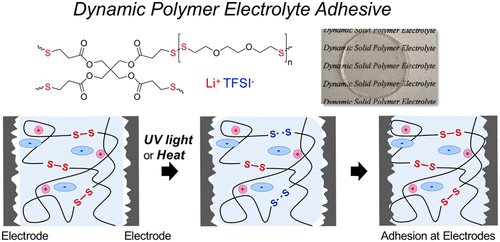当前位置:
X-MOL 学术
›
ACS Macro Lett.
›
论文详情
Our official English website, www.x-mol.net, welcomes your
feedback! (Note: you will need to create a separate account there.)
Ion-Conducting Dynamic Solid Polymer Electrolyte Adhesives
ACS Macro Letters ( IF 5.1 ) Pub Date : 2020-03-19 , DOI: 10.1021/acsmacrolett.0c00142 Ryo Kato 1, 2 , Priyadarshini Mirmira 1, 3 , Arvin Sookezian 2, 3 , Garrett L Grocke 1, 2 , Shrayesh N Patel 1, 2, 4 , Stuart J Rowan 1, 2, 3, 4
ACS Macro Letters ( IF 5.1 ) Pub Date : 2020-03-19 , DOI: 10.1021/acsmacrolett.0c00142 Ryo Kato 1, 2 , Priyadarshini Mirmira 1, 3 , Arvin Sookezian 2, 3 , Garrett L Grocke 1, 2 , Shrayesh N Patel 1, 2, 4 , Stuart J Rowan 1, 2, 3, 4
Affiliation

|
Cross-linked polymer electrolytes containing structurally dynamic disulfide bonds have been synthesized to investigate their combined ion transport and adhesive properties. Dynamic network polymers of varying cross-link densities are synthesized via thiol oxidation of a bisthiol monomer, 2,2′-(ethylenedioxy)diethanethiol, and tetrathiol cross-linker, pentaerythritol tetrakis(3-mercaptopropionate). At optimal loading of lithium bis(trifluoromethane-sulfonyl-imide) (LiTFSI) salt, the ionic conductivities (σ) at 90 °C are about 1 × 10–4 and 1 × 10–5 S/cm at the lowest and highest cross-linking, respectively. Notably, in comparison to the equivalent nondynamic network, the dynamic network shows a positive deviation in σ above 90 °C, which suggests the enhancement of ion transport occurs from the difference in structural relaxation on account of the dissociation of disulfide bonds. Lap shear adhesion and conductivity tests on ITO-coated glass substrates reveal the dynamic network exhibits a higher adhesive shear strength of 0.2 MPa (vs 0.03 MPa for the nondynamic network) and higher σ after the application of external stimulus (UV light or heat). The adhesive strength and σ are stable over multiple debonding/rebonding cycles and, thus, demonstrating the utility of these structurally dynamic networks as solid polymer electrolyte adhesives.
中文翻译:

离子传导动态固体聚合物电解质粘合剂
已经合成了包含结构动态二硫键的交联聚合物电解质,以研究它们的结合离子传输和粘合性能。通过双硫醇单体 2,2'-(乙二氧基)二乙硫醇和四硫醇交联剂季戊四醇四(3-巯基丙酸酯)的硫醇氧化合成了不同交联密度的动态网络聚合物。在双(三氟甲磺酰亚胺)锂 (LiTFSI) 盐的最佳负载量下,90 °C 下的离子电导率 (σ) 约为 1 × 10 –4和 1 × 10 –5分别在最低和最高交联处的 S/cm。值得注意的是,与等效的非动态网络相比,动态网络在 90 °C 以上的 σ 中显示出正偏差,这表明由于二硫键的解离导致的结构弛豫差异导致离子传输的增强。在涂有 ITO 的玻璃基板上进行的搭接剪切粘合力和电导率测试表明,在施加外部刺激(紫外光或热)后,动态网络表现出 0.2 MPa 的更高粘合剪切强度(而非动态网络为 0.03 MPa)和更高的 σ。粘合强度和 σ 在多个脱粘/再粘合循环中是稳定的,因此证明了这些结构动态网络作为固体聚合物电解质粘合剂的实用性。
更新日期:2020-04-23
中文翻译:

离子传导动态固体聚合物电解质粘合剂
已经合成了包含结构动态二硫键的交联聚合物电解质,以研究它们的结合离子传输和粘合性能。通过双硫醇单体 2,2'-(乙二氧基)二乙硫醇和四硫醇交联剂季戊四醇四(3-巯基丙酸酯)的硫醇氧化合成了不同交联密度的动态网络聚合物。在双(三氟甲磺酰亚胺)锂 (LiTFSI) 盐的最佳负载量下,90 °C 下的离子电导率 (σ) 约为 1 × 10 –4和 1 × 10 –5分别在最低和最高交联处的 S/cm。值得注意的是,与等效的非动态网络相比,动态网络在 90 °C 以上的 σ 中显示出正偏差,这表明由于二硫键的解离导致的结构弛豫差异导致离子传输的增强。在涂有 ITO 的玻璃基板上进行的搭接剪切粘合力和电导率测试表明,在施加外部刺激(紫外光或热)后,动态网络表现出 0.2 MPa 的更高粘合剪切强度(而非动态网络为 0.03 MPa)和更高的 σ。粘合强度和 σ 在多个脱粘/再粘合循环中是稳定的,因此证明了这些结构动态网络作为固体聚合物电解质粘合剂的实用性。











































 京公网安备 11010802027423号
京公网安备 11010802027423号